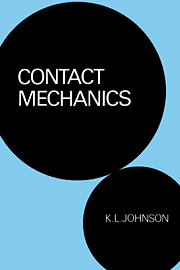Book contents
- Frontmatter
- Contents
- Preface
- 1 Motion and forces at a point of contact
- 2 Line loading of an elastic half-space
- 3 Point loading of an elastic half-space
- 4 Normal contact of elastic solids – Hertz theory
- 5 Non-Hertzian normal contact of elastic bodies
- 6 Normal contact of inelastic solids
- 7 Tangential loading and sliding contact
- 8 Rolling contact of elastic bodies
- 9 Rolling contact of inelastic bodies
- 10 Calendering and lubrication
- 11 Dynamic effects and impact
- 12 Thermoelastic contact
- 13 Rough surfaces
- Appendices
- References and author index
- Subject index
8 - Rolling contact of elastic bodies
Published online by Cambridge University Press: 05 June 2012
- Frontmatter
- Contents
- Preface
- 1 Motion and forces at a point of contact
- 2 Line loading of an elastic half-space
- 3 Point loading of an elastic half-space
- 4 Normal contact of elastic solids – Hertz theory
- 5 Non-Hertzian normal contact of elastic bodies
- 6 Normal contact of inelastic solids
- 7 Tangential loading and sliding contact
- 8 Rolling contact of elastic bodies
- 9 Rolling contact of inelastic bodies
- 10 Calendering and lubrication
- 11 Dynamic effects and impact
- 12 Thermoelastic contact
- 13 Rough surfaces
- Appendices
- References and author index
- Subject index
Summary
Micro-slip and creep
In Chapter 1 rolling was defined as a relative angular motion between two bodies in contact about an axis parallel to their common tangent plane (see Fig. 1.1). In a frame of reference which moves with the point of contact the surfaces ‘flow’ through the contact zone with tangential velocities V1 and V2. The bodies may also have angular velocities ωZ1 and ωZ2 about their common normal. If v1 and v2 are unequal the rolling motion is accompanied by sliding and if ωz1 and ωz2 are unequal it is accompanied by spin. When rolling occurs without sliding or spin the motion is often referred to as ‘pure rolling’. This term is ambiguous, however, since absence of apparent sliding does not exclude the transmission of a tangential force Q, of magnitude less than limiting friction, as exemplified by the driving wheels of a vehicle. The terms free rolling and tractive rolling will be used therefore to describe motions in which the tangential force Q is zero and non-zero respectively.
We must now consider the influence of elastic deformation on rolling contact. First the normal load produces contact over a finite area determined by the Hertz theory. The specification of ‘sliding’ is now not so straightforward since some contacting points at the interface may ‘slip’ while others may ‘stick’. From the discussion of incipient sliding in §7.2, we might expect this state of affairs to occur if the interface is called upon to transmit tangential tractions.
- Type
- Chapter
- Information
- Contact Mechanics , pp. 242 - 283Publisher: Cambridge University PressPrint publication year: 1985
- 2
- Cited by



